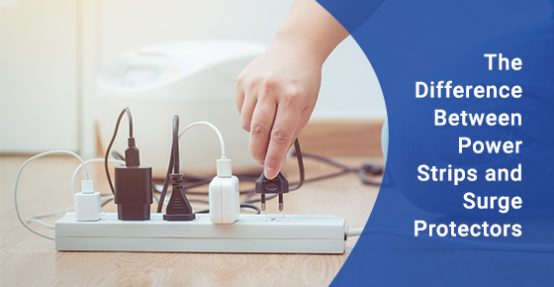
With all of the countless gadgets and electronics many of us tend to use, it’s no wonder why additional electric sockets would be needed over time. For this reason, many people turn to various options to provide them with extra outlets.
If you are presently shopping around for these additional outlets, you have perhaps become perplexed by the use of power strips and surge protectors. The question you are most likely asking yourself is, what’s the difference?
In this article, we will give you a clear explanation to help educate you and guide your decision as you choose the right outlet for your home.
A power strip is essentially an extension cord that comes equipped with additional outlet spaces. It is also identified as a power block or power strip. These strips are typically plugged into a wall.
It’s very useful as it enables more than one device to be plugged in and used without disconnecting other devices. Instead, this power bar offers practicality and an increase in the number of outlets that can be used and accessed easily.
A power surge protector is quite different from a power strip, as it protects electronics from voltage spikes, which can cause undesired harm to electronic equipment. This device works to minimize the amount of voltage delivered to devices to maintain a safe threshold of power. Doing so helps to limit the transient waves of current, which can damage appliances and other electrical devices.
A power surge occurs when the voltage in the power system rapidly rises above its limit. The consequences of this overvoltage can be quite precarious, often causing permanent damage or a sudden blaze. However, these unexpected surges can result from faulty or improper wiring, and fluctuations in power as devices switch on and off.
A lightning strike can also cause a significant increase in voltage. This natural phenomenon can cause a massive jump in volts, leading to enormous and unmanageable upsurges of power. In some instances, complete power outages are the outcome.
There is a common misunderstanding between these two devices. This confusion arises because they look very similar. For individuals navigating the market to find additional electrical sockets, you are likely aware of how these two closely resemble. However, by correct examination, you can adequately identify the tell-tale variance on their packaging.
Surge protector packaging often indicates a joules rating, such as 3000 joules, which is a measurement of energy. This rating is essential in understanding how long your devices will be safeguarded from an upsurge of energy or power.
After several surges, though, the protection will deplete. It can even be consumed with a single voltage surge; however, this reduction is course dependent on the severity of the strike. Most surge protectors brandish a light or alarm indicator, which notifies you of its exhaustion.
Power strips are especially handy when you have several neighbouring electronics that need to be plugged into an outlet. They offer practicality and convenience, an element that traditional outlets in homes are unable to offer. The advantage of power strips is that they have multiple outlets, making them great for using many devices at a time.
These extensions offer a quick-solution for individuals wanting to provide power to several electronics. Many power strips provide an on/off switch, which is suitable for conserving energy. They are also reasonably priced but increase in price, depending on the different features they afford.
Surge protectors offer the same advantages as a power strip. Various electronics can be used as it provides multiple electrical outlets. The clearest benefit of this addition is that it protects the devices that are plugged into it.
A surge protector limits the occurrences of overvoltage, which is likely to occur when many devices are being used at once. Hence, a computer, television, computer charger, or phone charger can be plugged in and powered on without concern for overvoltage.
Fortunately, surge protectors are not too expensive. However, depending on the number of joules offered, or the features afforded, the price may increase. Overall, it does an excellent job of protecting your high-priced electronics.
The best option is dependent on your needs, as businesses and residential clients have different requirements. This is especially true because companies use more robust appliances and devices that require more voltage and charge to support their functions. A typical power strip or a surge protector with 3000 joules may not be appropriate, and a commercial power surge protector may be better suited.
However, it is essential to note that there is no harm in purchasing a surge protector for your home. It offers dual benefits, such as additional accesses for your electronics and heightened protection for your electronics. Overall though, it is for you to decide as some power strips do offer surge protection.
To learn more about the difference between power strips and surge protectors, call Hi-Lite Electric at 416-800-5536 or contact us here.
© 2024 Licensed Electrical Installation & Service – Hi-Liteelectricinc.ca
All Rights Reserved.
Leave A Comment